Story: A weekend away with Juliana's Joplin
I got my first peek at Juliana’s new Joplin at the Maverick launch, in the middle of last year. It looked very similar to the Maverick, with a little less beef. When the time came to ride it in real life I was lucky enough to be chosen again. The top CC X01 RSV build was sent and I set to work getting it dialled in.
Initially, the idea was to go for a ride with Juliana Ambassador Anka Martin; to take the Joplin on a meandering overnight journey on the Paparoa Track. Unfortunately for West Coast residents, a devastating storm had ripped through and, as well as blocking people from movement momentarily, it caused a slip midway through the track that wouldn’t be cleared fully by the time we were planning to ride it.
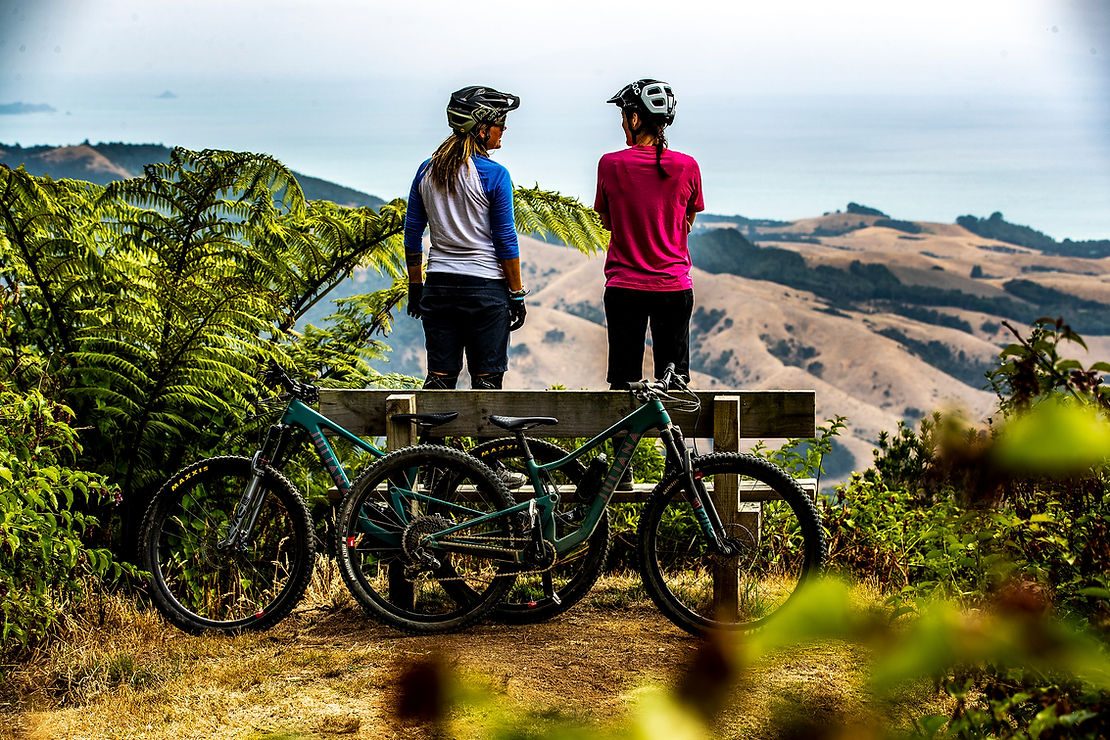
So, with the Paparoa track now on a growing list of New Zealand trails I will ‘one day ride’, we had to make other plans. Unconventional timetables aligned on the weekend following Valentine's Day. This timing also happened to align with Jamie Nicoll’s North Island Nomadic Weekend at 440 MTB Park (and the final round of the National DH series). So, I farewelled my Valentine and headed north, through scorched pastures with cows nibbling on dehydrated blades of grass; past the many signs selling seaweed fertiliser and up to the coast, with beautiful turquoise waters and white sand beaches abruptly turning to a beautiful rocky mess.
Thoughts ran back and forth through my head as I drove, casting doubt on whether a bike park would be the ideal weekend riding away with the Joplin - a bike which has its origins in the cross-country realm of the Juliana range. Turns out, the worries were all in vain.
I had told people I was off to Auckland for the weekend, however, in small town terms, 440 is so far away from Auckland it may as well be in another town. It’s about an hours’ drive to get there from the city. Not quite far enough to escape the glow of the city at night, but more than enough to escape into the peace and quiet of nature. The stars twinkled in the sky regardless and the expected winds came, rhythmically whipping the straps of the bike rack into the boot of my car. Not rhythmically enough to send me to sleep, though, so I hauled myself out of my back seat bedroom to end the tapping.
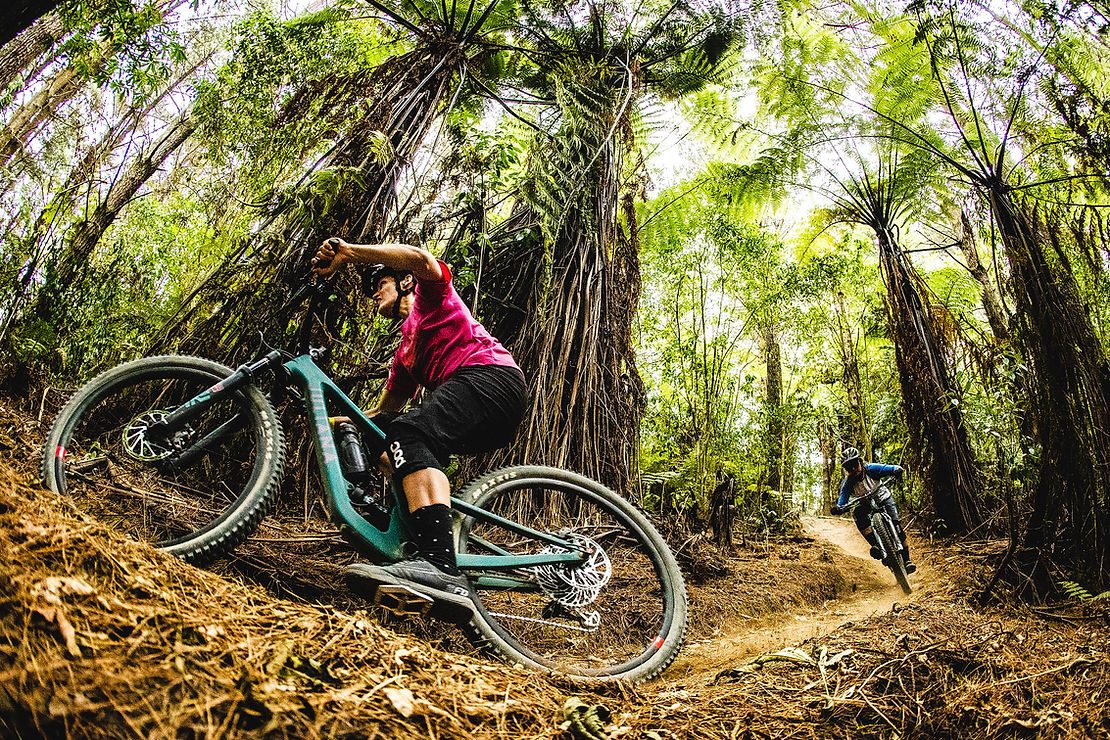
In the morning, we rolled out of the campsite to get our spots in the shuttle. From the drop off, we climbed a short while and took in the spectacular views of the Firth of Thames and islands sitting off to the east of Auckland, then headed into Doozas. This pine forest trail was fun and fast with its looseness and a few chunky roots chucked in; the kind of stuff the Joplin loves to float along.
It helped that I’d managed to ride the bike for over a month on trails I was really familiar with at home in Rotorua, which were a bit like this. This meant that I had the setup pretty much perfect for my style of riding. I did find it took longer to get there though, with much more tweaking required. I put this down to the shorter travel and needing to find the right balance of suppleness and firmness, while still getting full travel out of the suspension. It took more finesse to set up the suspension, just like it required a little more finesse on the trails heading down. It’s not a point and shoot bike and I found myself picking my lines more carefully to find patches in the trail to unweight, in order to loft over the rougher stuff.
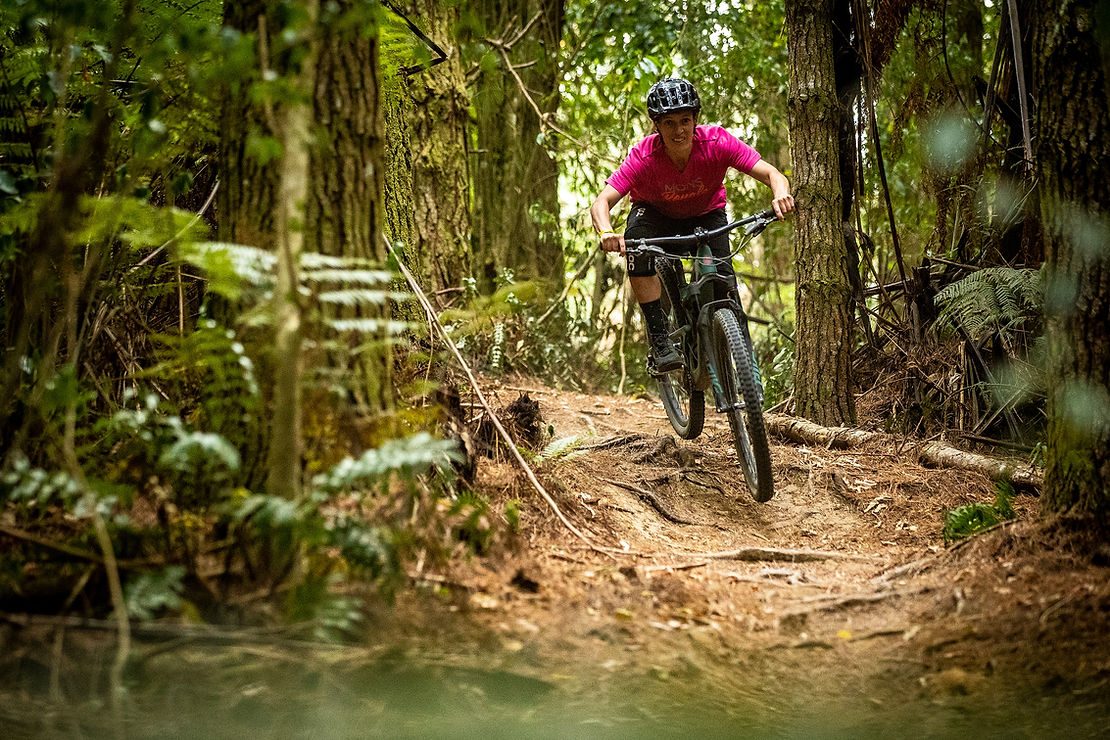
Initially, I was dubious about the capabilities of myself on such a short travelled bike. If I hadn't already known it had 120mm rear and 130mm front suspension, I might not have ever realised - it certainly didn't feel like your average short travel. I felt like Marie Kondo had come along and gotten rid of what I truly didn't need, which left me riding with only the necessities of suspension. The short travel isn’t an issue when the trail gets a bit hairy, thanks to the ‘longer, lower, slacker (and steeper)’ mantra of modern day bicycle designers. This significantly updated version gets a 20mm longer reach, 2.3° slacker head angle and a 3.7° steeper seat angle, compared to the previous one from a few years ago.
Like the Santa Cruz equivalent, the Tallboy, the shock mount drops down to the seat tube tunnel of love. This lower link VPP platform felt supportive when pedalling and I couldn’t feel it bottom out, even though the O-ring indicated I definitely had. On the shock mount there’s the ability to tweak the bike with a high/low flip chip. I had already felt a bit of pedal whack with my big, old, clumsy flat pedals in the high setting, so I was a little nervous dropping the bottom bracket a touch further (3mm) towards rocks and stumps. I gave it a go anyway. Is it ok to say I didn’t really feel much of a difference between the two settings? Yes, I think it is. The angles don’t change heaps, moving from a 65.7° head tube to a 65.5°, and the seat tube gets about 0.3° slacker too.
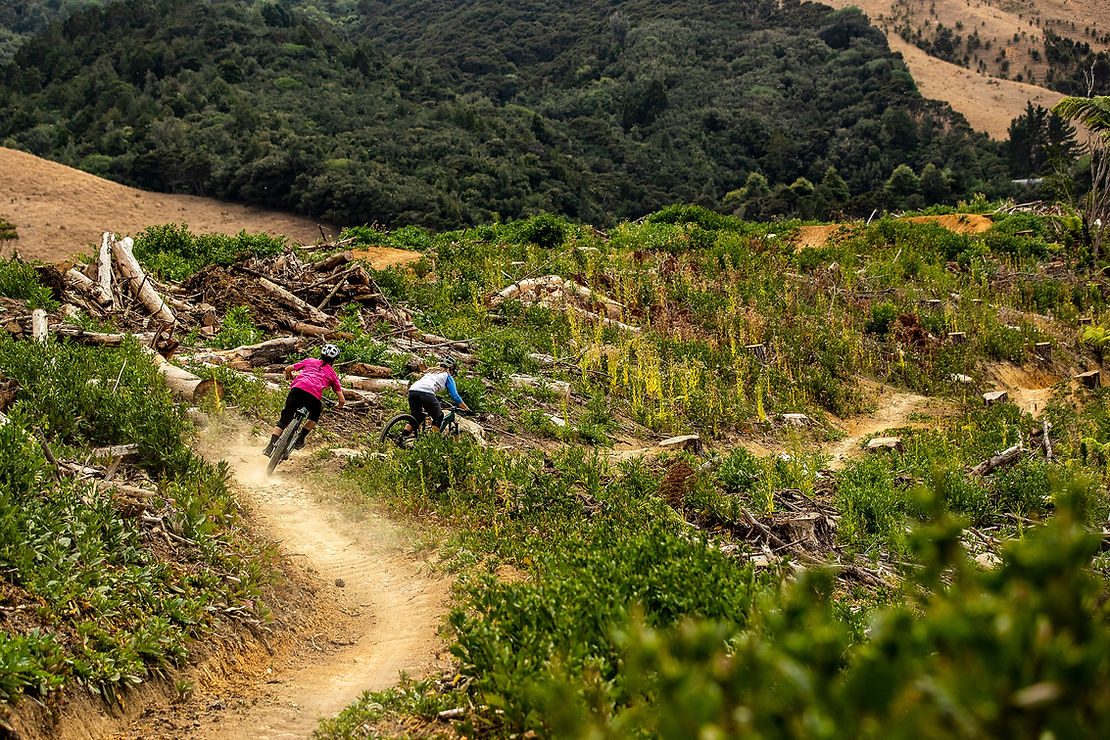
Another adjustment that can be made to the frame is out the back, at the chainstay. A second flip chip lengthens the 430mm stay out to 440m. Again, I had a preconceived thought that I would prefer the shorter, more ‘playful’ option, but I found the extra length added a little more stability for not much sacrifice in liveliness. I could still get off the ground when I wanted to. And I wanted to - a lot - with this bike. It’s light, and just mauling through chatter doesn't work the same on the Joplin compared with a bigger travel bike. On longer rides, where I was too fatigued to work the trail over rougher terrain, I felt myself becoming a bit of a passenger. But as Janis would say; “You got to triiieeeiieeieeiy (just a little bit harder)”. It was only on these longer, more technical rides, with some really rough stuff in the way, where I found myself thinking that a few more millimetres would be handy. Riding the bike, 98% of the time it was 100% within its limits. The 2% where it was not was, coincidently, was where I was also reaching mine.
We then headed up again to one of the patches of native flora. Kauri, nikau and ponga trees enclose the Damn Native trail. Clay soil has been sculpted into berms, winding you down into the creek and out the fire road on the other side of the valley, necessitating some climbing. Even on these mellower roads, the blue lever on the FOX Float Performance Elite DPS shock stayed in the full open position. There was some movement in the shock, but it was firm enough not to lose pedalling efficiency.
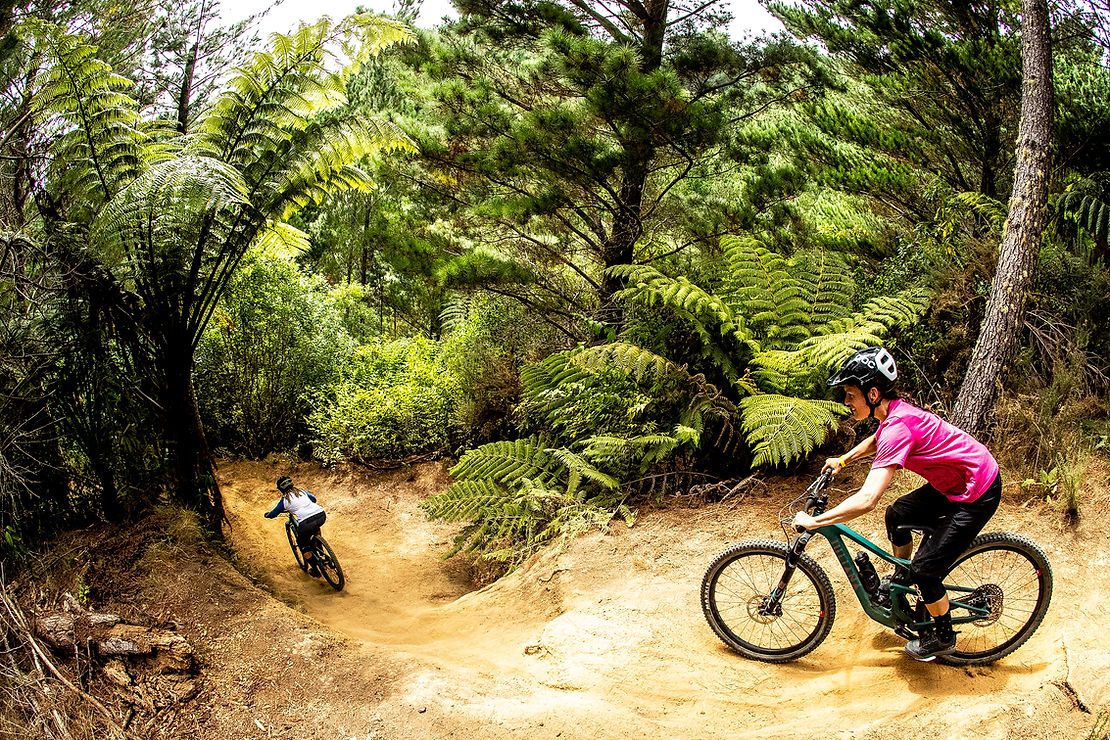
On steeper, more technical pinches back home in Whakarewarewa - like the ones lurking out in the native bush of Tuhoto Ariki - it felt easy to manoeuvre over steep obstacles with a bit of momentum. The climbing abilities came through in faster speeds up hill. On flowing single track I felt like an ewok who had stolen a speeder bike, zooming through the trees. It helps being almost a kilo lighter than the other 29er in the Juliana lineout, the Maverick, too.
More shuttles were met with more nice flowy, techy and dusty routes down. A post ride cool down and wash is a short walk across the road, in a swimming hole in the creek that flows down to the sea. Saturday evening came, and we were treated to a home cooked curry, rice and naan - this was paired nicely with generously donated Parrot Dog beers. Hungry trail dogs waited impatiently to lick any last remaining scraps from bowls and a couple of turkeys ran up the track across from the campsite. At dusk, we all sat around a dusty projector listening to tales of the past and future, inspired by crazy schemes. Jamie spoke of travels to communities, not just to tear through them, but to engage with the people who live in them. What he’s got planned is equally impressive: he’s modifying an old Toyota Land Cruiser, fit to transport him and his bike over land and sea to Europe. Writing that sentence makes it seem so easy, but looking on the map with him puts into perspective what an immense feat it will be.
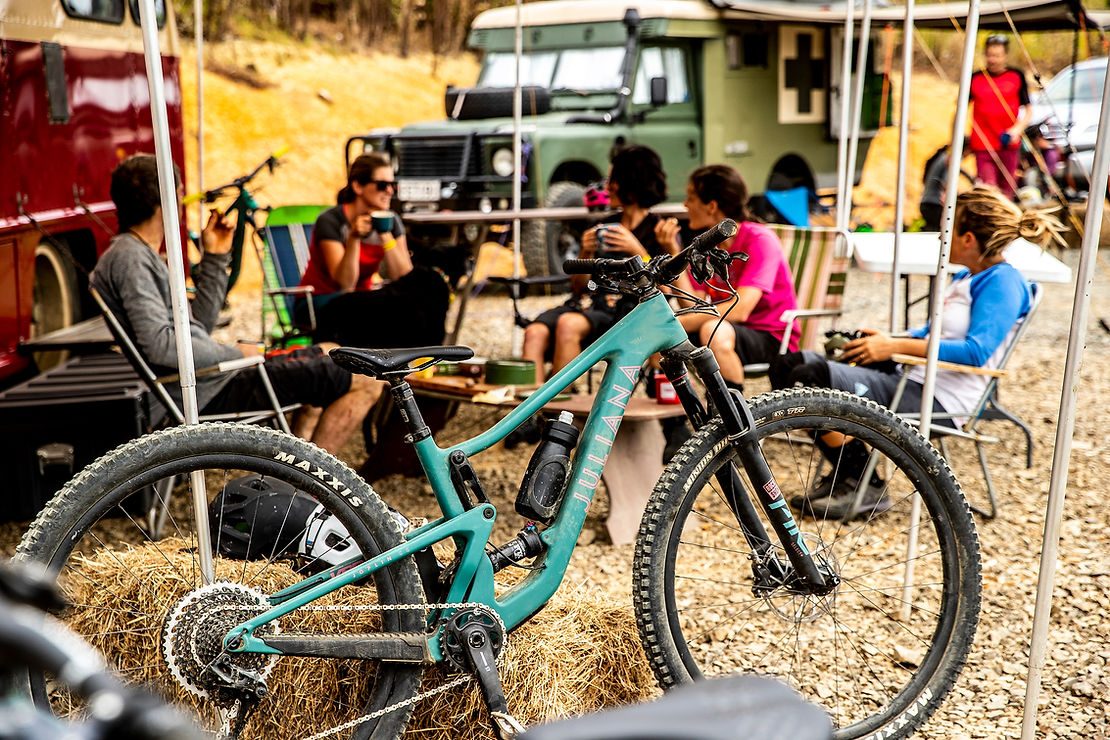
Next up was Anka, to show us what she did in her 2019. It’s crazy to think that everything she showed us happened in one year! The part that stood out for me was her time in Roma, Lesotho. Anka, along with Claudio Caluori from Velosolutions - who had previously built a world-class pump track there - ran the Red Bull pump track qualifier. Along with the win came the opportunity to compete in the World Championship in Switzerland. Anka helped the local riders - one of them winning by marginally beating a guy from South Africa who had travelled there in hope of an easy entry. These acts enrich communities, bringing them together. And there are plenty of places to go to right in front of us, living here in Aotearoa. This was especially apparent when we watched the slide show of amazing locations, many of which looked like they could have belonged in New Zealand. It was really good to get to know Anka a bit more than knowing of her through watching her rad videos. While listening to Anka and Jamie I didn't feel too much like a nomad, but I enjoyed listening to nomadic tales from people who live their lives as travellers of the world.
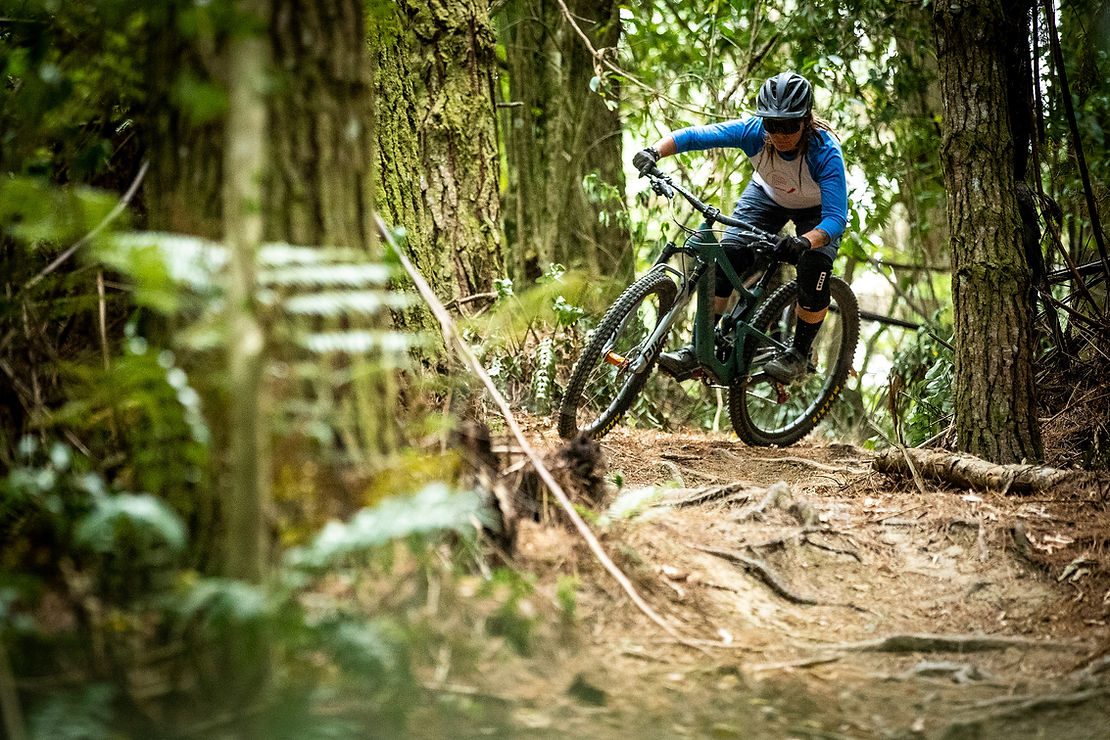
On Sunday morning, Friday’s smell of freshly laid asphalt had disappeared and the newly sealed pump track was ready to use. The Nomadic Weekend culminated in ‘musical pump track’, a game very loosely based on musical chairs. Underneath the gumtree filled with a variety of birds, and a drone hovering nearby, and a confused dog barking, everyone piled onto the track to ride around until the music stopped. The winner was whoever ended up closest to the speaker. I was far from the first winner and came away with a sweet Ground Effect jacket; the greatest prize, however, was a set of Santa Cruz Reserve wheels. Lucky Chris!
It was great getting to know the Joplin, and to make new connections with some of the people who make this brand what it is. It’s a bike that can be as versatile as the rider. The riders I've talked to who love their Joplins and Tallboys and ride them hard - and exclusively - have up-forked them themselves, to 140mm in the front. For the Pike Select+ this requires a new air spring getting fitted, which seems an easy upgrade if that's the style of riding the bike is being used for. To further beef the bike up, the stock Maxxis Minion DHF/R 2.3’s could get fattened. The frame also allows 2.6’s when the rear axle flip chip is in the longer position. I liked the feel of the 2.3s on the trails I rode, but it’s nice knowing you have other options. On the other hand, it’s also a bike longing for a backcountry adventure - heck, it's even got two bottle mounts! As for the middle ground, those every day riding missions, it’s a heap of fun.
Words: Rachel Reynolds
Images: Sven Martin
News: Pirelli Launch new Scorpion XC RC Tyres
Pirelli carry some pretty heavy clout when it comes to making tyres, being the supplier for Formula 1. We've been fans of everything they've done in the mountain biking space since their return in 2019, and they've just launched their latest MTB line: the Scorpion XC RC tyre. Developed with the Trek Pirelli XC team, the Scorpion XC RC is designed 100% for racing.
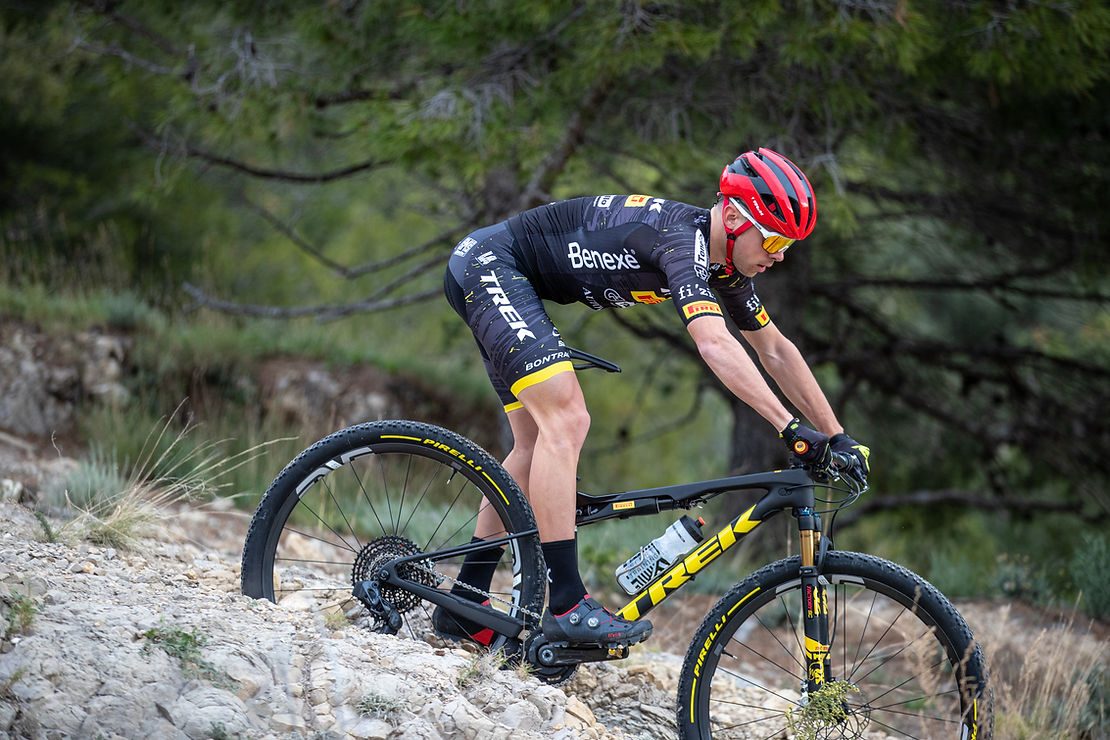
"Developed at the specific request of TREK PIRELLI athletes, the new tyre is a 100% racing product. It’s created to meet the high performance needs of riders of the caliber of Vlad Dascalu, a European Champion, World Champion and World Cup winner XCO U23, and Samuele Porro, an Italian National Champion, silver medal at the European Championships and bronze at the World Championships in the XCM category.
Samuele Porro had asked Pirelli engineers for a new tyre more oriented towards the Olympic Cross- Country races but also with excellent performance in the XCM events. The company technicians have therefore developed a racing product of the highest profile, capable of offering lightness, super smoothness and good grip. Thus, the Scorpion XC RC was born.
A VERY FAST RUBBER, FOR RACES
A few months later, in October 2019, Samuele Porro and his teammates received the first prototypes. The new tyres with the "Prototype" label were tested during the team's training camp in Calpe (Spain). Porro also tested them in a training session on the track of the grueling Cape Epic in South Africa. The baptism of the tyres took place in the first calendar races, including the Mediterranean Epic and the Andalucia Bike Race.
From a technical point of view, the new XC RCs are Tubeless Ready tyres with a 120 TPI Nylon casing construction. Available in LITE and ProWALL versions, for increased puncture protection, they combine Pirelli's proprietary technologies already found in the Scorpion MTB range, starting with the innovative SmartGRIP Compound. Derived from Pirelli's experience in Motorsport, SmartGRIP Compound is a mono-compound with high mechanical strength which, despite the increased smoothness and lightness of the new XC RC tyres, offers excellent stability, long life and, above all, optimal grip on all terrain. Pirelli paid particular attention to the tread design, which incorporates characteristics deriving from both the Scorpion XC H (Hard) and the Scorpion XC M (Mixed), re-engineered to have more direct and precise handling. The blocks in the center of the tread clearly resemble the Scorpion XC H profile but are lower and closer to improve the smoothness on straight sections. And the half-fold and lateral blocks have the shape and sharp angle of the Scorpion XC M profile. These revisions were made to maximize grip at different lean angles. The profile with more aggressive sides and a smoother center makes the Scorpion XC RC the perfect weapon to conquer the modern Olympic Cross-Country tracks that are very technical.
This is Vlad Dascalu’s comment on the new tyres: “the Scorpion XC RC is perfect for me, because it is designed for the most modern XC courses, where the alternation of natural trails and artificial sections is increasingly common, in addition to an increased racing average speed that’s augmenting year by year. Thanks to the new design I know exactly where I can put the tyre, I can follow the most difficult lines and I can set the curves with more aggression, but also save energy, thanks to the improved smoothness and lightness (of the tyre - editor's note) ".
“Scorpion XC RC is a perfect tyre for XC competitions - commented Samuele Porro - Smooth and precise in high speed corners. The new, higher, side block ensures optimal grip when driving to the limit "
The new Scorpion XC RC is already available in the best cycling shops, in the 29”x 2.2 version, also in the “Team” color variant (with yellow logos)."
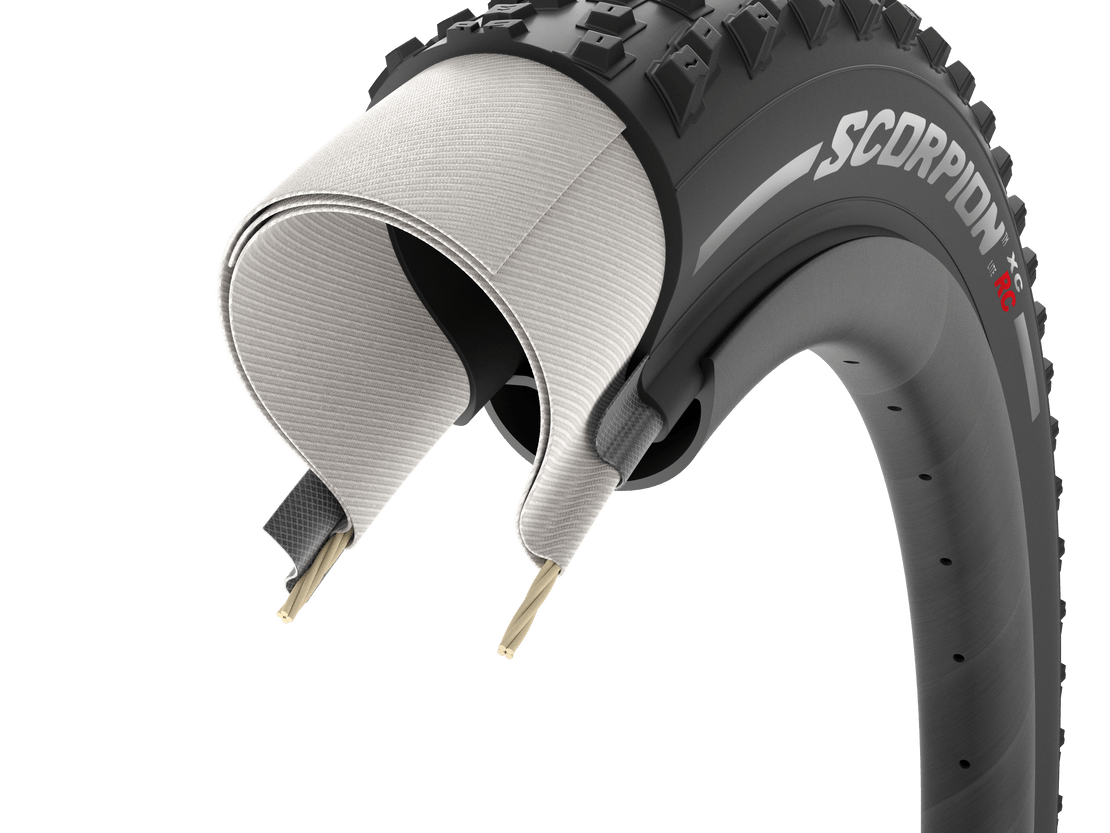
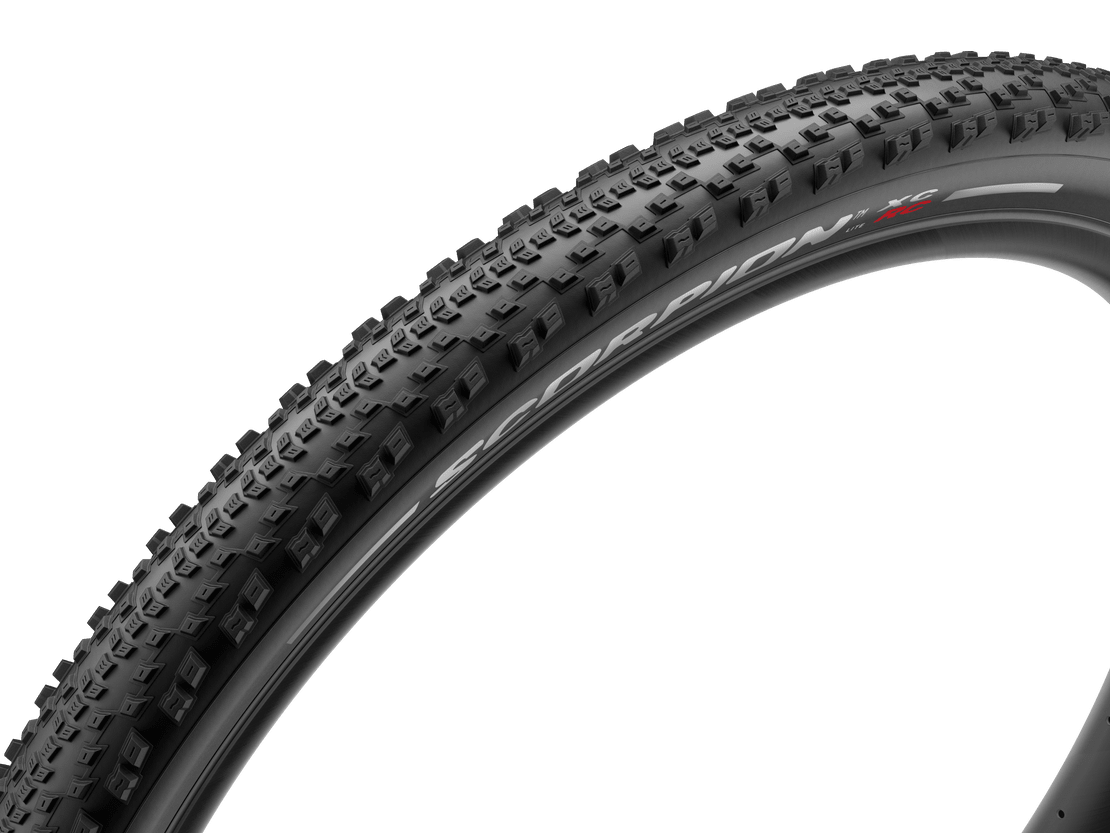
News: Roval's new Control SL Team Wheels
Cross Country racing is pretty exciting these days, with super tight racing on some courses that are pretty technical, compared with the courses of years gone. Roval's new Control SL Team Wheelset are designed to meet the needs of modern XC. They come in at a claimed weight of 1240g for a complete set, and a nice, wide 29mm internal width for plenty of traction and a little more cushion. Keep reading for the full release from Roval.
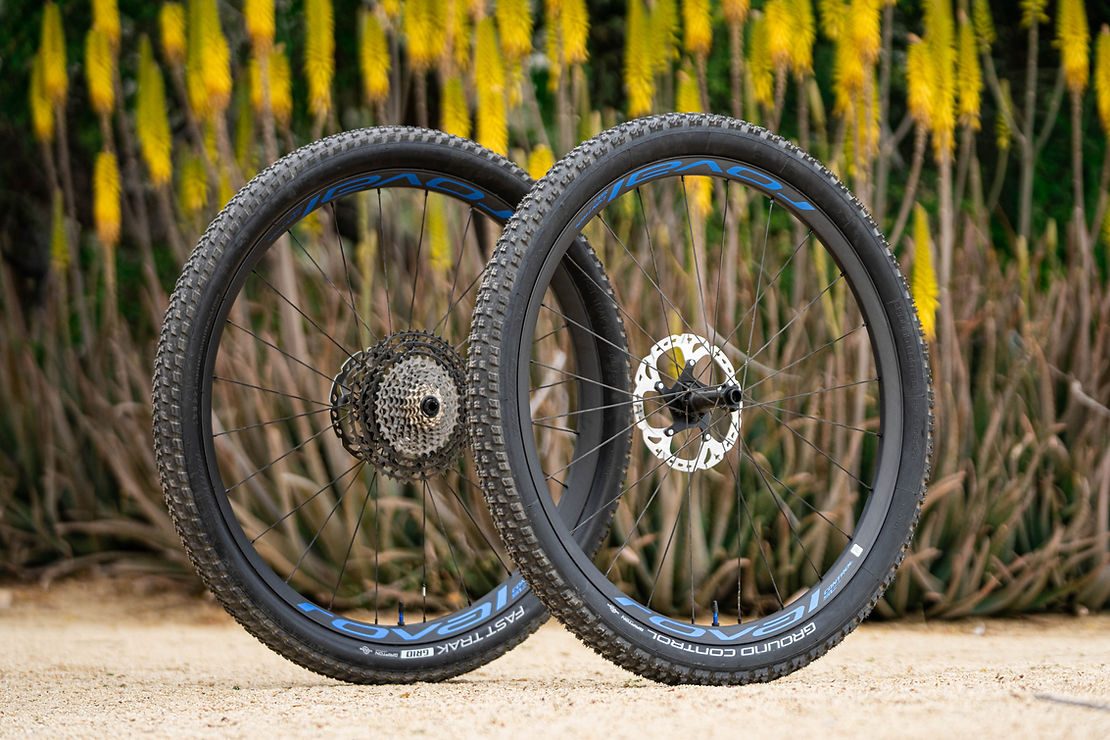
"Bringing the new Control wheels to life involved a rigorous cross-examination of everything we’ve ever done, and ultimately led us to develop an entirely new wheelset from axle to rim. The new Control is an exercise in radical design, no-holds barred engineering, and state of the art production.
Weight is always going to be a paramount concern when it comes to XC wheels. Every single gram counts when hunting podiums or personal bests. Rotational mass is the enemy of speed; it dulls handling and saps precious watts. Being heavier than other light wheels doesn’t win races. Being the lightest might. At 1240 grams per set, the new Control SL Team Issue is the one of the lightest mountain bike wheelsets on the market. It’s also lighter than most road wheelsets.
Durability matters. Having the lightest wheels used to be good enough for bragging rights, no matter how questionable the longevity. Those days are gone. The lightest wheels on the market aren’t worth much if they can’t deliver you to the finish line, or if they leave you stranded miles from the nearest road. Through rigorous prototyping and a grueling series of testing protocols — both in the test lab and in the real world — the new Control delivers a toughness and durability exceeding that of many much heavier all-mountain wheels.
Ride quality is tailored to the demands of modern XC and trail riding. The shape of the new Control rim is carefully designed and laid up to be laterally stiff so that they track with precision, yet vertically compliant enough to deaden trail buzz and deliver a smooth ride. This ensures razor sharp handling without harsh side effects, ultimately reducing rider fatigue and improving lap times.
Pinch protection is something that most people don’t talk about. Meanwhile, the single biggest time loss in XC racing is due to flat tires. So it makes sense that if the goal is getting from point A to point B as fast as humanly possible, then something should be done to reduce the risk of flat tires.
Notice the top of the rim wall on the new Control rim. See how it’s wider than usual? We stopped accepting the status quo and decided to do something about pinch flats. That rim top is 4mm wide, and this width and specifically designed shape means that it takes 22% more force to pinch a tire than before. Rider can now ride harder, on lighter tires, at lower pressures, with fewer flats. Beyond any talk of gains made by less rotational weight or improved ride quality, reducing the risk of flat tires GUARANTEES a faster wheel.
-
Fewer flats: 4mm flat-top requires 22% greater force to pinch-flat
-
Greater durability: System approach of combining asymmetrical rim with custom designed hubs which help balance spoke tension and allow single spoke length assembly
-
More control: 29mm internal rim-width reduces squirm and increases tire volume
-
Better ride: Double the vertical compliance with 29% more impact strength keeps you on line and maintains grip and speed
Instant classic, limited edition
1240 grams is an obscenely light weight when talking about mountain bike wheelsets, the kind of weight that XC racers dream about. But light weight alone is no longer enough. So, we sweated the details and engineered the new Control SL Team Issue wheels to be sharp handling, smooth riding, extra durable, and less likely to pinch-flat your tires, in addition to being some of the lightest weight production wheels on the planet.
No punches were pulled. These wheels use the lightest hubs Roval has ever made, period, along with a rim that has been designed from the ground up to meet the rigors of modern high-performance XC riding and racing. This is a very limited production run, carefully hand-built and finished with a special graphic treatment.
Control SL Team Hub
To build the lightest wheels, you have to consider every single component that goes into those wheels. The hubs on the Control SL Team Issue are a prime example of that detailed scrutiny. They are the lightest Roval hubs ever made. Straight pull spokes use slightly less material than j-bends, so they were used here. The spoke holes are drilled at a precise angle to match the rims directly without any undue stress.
The freehub utilizes DT Swiss’ EXP mechanism; 54t engagement, fewer moving parts than before, less drag, and outboard bearing placement all work to ensure that these wheels deliver strength and durability without any excess flab.
Asymmetry begets symmetry
The asymmetric design of the Control rim offers some subtle but important benefits. With the spokes offset to one side of the rim, this allows us to reduce the spoke offset that usually occurs at the hub. In turn, this means we can generate greater bracing angles for the spokes between the hub and rim, while also minimizing the spoke tension differential that often occurs between drive and non-drive side spokes. The end result is a wheel that is stronger, laterally stiffer, more durable, and in the case of the Control, allows us to utilize the same length spoke throughout the whole wheelset.
Testing:
Design. Prototype. Test. Test again. Every step of the Control design and prototyping process leads to this. Control field testing included a deep pool of critical and talented riders around the globe, who punished our work in all conditions, from World Cup races to crushing backcountry miles. They made it their mission to sniff out weaknesses and expose them. Sometimes they sent us back to the drawing board, and we thanked them every time. Control wheels also endured thousands of hours of gruelling lab tests—simulating exaggerated real world forces – generating relevant data regarding strength, stiffness, weight, and other critical measures. We compared the test data to all the relevant wheels we’ve made in the past, and to every respected wheel in the market.
The result? Control wheels excel in both qualitative and quantitative test results."
News: Trek's #GoByBike
Over lockdown, I’m sure many of you turned to your bikes for to let off some steam and to enjoy the outdoors. Whilst most of us weren’t able to ride trails, just going for a pedal around the block made a huge difference to my days and no doubt helped keep me sane.
Riding helps keep us healthy, but it also helps our planet if you’re able to make a trip by bike, that you’d usually make by car. Trek’s #GoByBike movement encourages you to take at least one trip by bike, a week, that you’d usually make by car. Now’s the perfect time to be making lifestyle changes, or continuing new habits, especially when they can make a positive impact on you and the planet we call home. For more, read Trek’s press-release below.
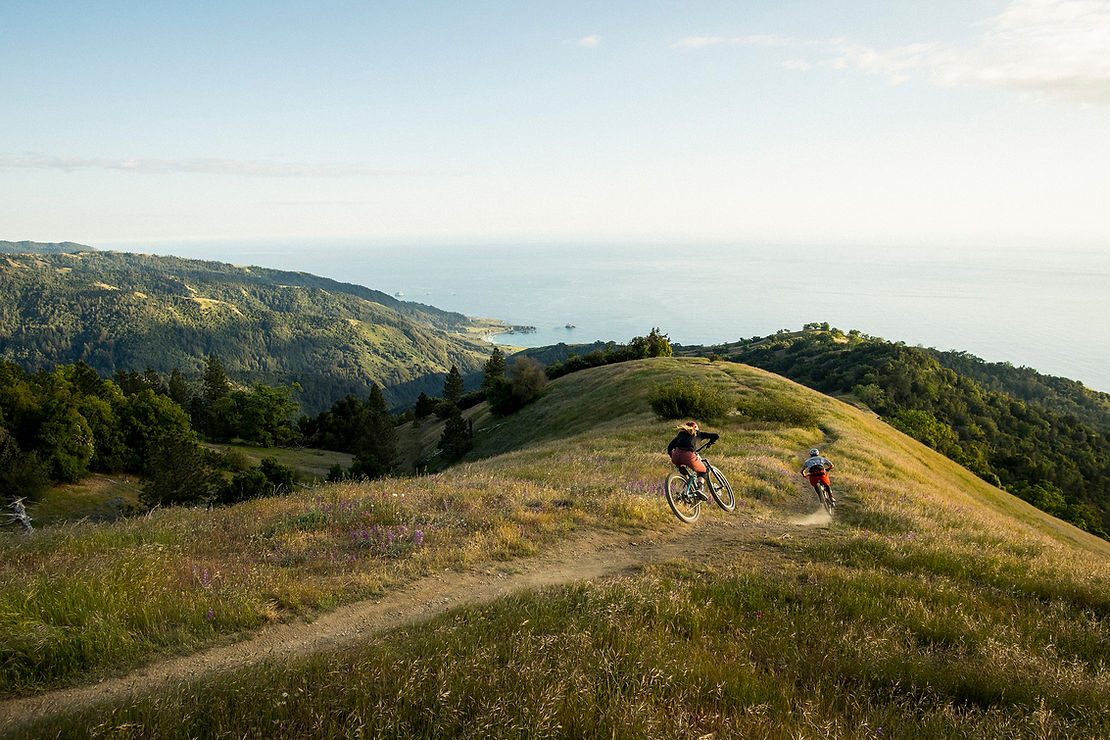
"There’s never been a better time to hop on a bike and go for a ride – and, whether it’s for essential travel, exercise, to let off some steam or to reduce your own personal carbon footprint, the benefits for you, your family, your community and your planet are clear. Trek Bicycle is creating sweeping collective action across the world with #GoByBike, a movement encouraging people to choose to ride a bike at least one trip a week, replacing other modes of transportation, with the goal of reaching 10 million trips for a healthier planet and population. While society is still social distancing, there’s never been a better time to support climate action and form new habits, inspiring people to choose a bike trip over a car trip as often as possible. “Now is the time to adjust our behaviors for the better and co-design a new normal that will have lasting impact on our people and planet,” says Trek Bicycle President John Burke.
For the planet, biking is climate action. Between rising global temperatures, melting ice caps, air pollution, and working to heal a delicate ozone layer, among other things, the world was in a tough spot before the global COVID-19 pandemic. It’s still in a tough spot. Air pollution contributes to 7 million deaths a year globally, according to the World Health Organization. It’s clear, though, that collective action can drive change. Cities, for example, that traditionally suffer from the world’s worst air pollution have seen reductions of air pollution by up to 60 percent from the previous year, during a three-week pandemic lockdown period. Replacing trips made by a car, bus, train or subway with a bike trip can reduce emissions and in turn impact our environment in a positive way.
“At Trek, we are moving fast on climate change. We have hundreds of action items we are taking to reduce our environmental impact, but the biggest thing we can do is to get more people to actually ride their bikes,” says Burke. “This is bigger than just an environmental crisis—it’s a health crisis, and in many places a congestion crisis, which will only continue to get worse as people opt to drive personal cars more in an effort to avoid public transportation and social distance. It is our hope that by encouraging the #GoByBike movement, everyone can look back together and be able to say they played their part in shaping a better future for themselves, their family, their community, and generations to come.”"
News: Cannondale's new Scalpel & Scalpel SE
Cannondale's new Scalpel is here! As with most bikes, the whole longer-lower-slacker-lighter thing rings true with the new Scalpel, with a longer reach, longer wheelbase and slacker head angle than the previous generation, and a frame that's 200g lighter. The Scalpel features 100mm travel, whilst the Scalpel SE features 120mm. Other highlights include a new suspension platform and integrated storage. Keep reading for the full release from Cannondale!
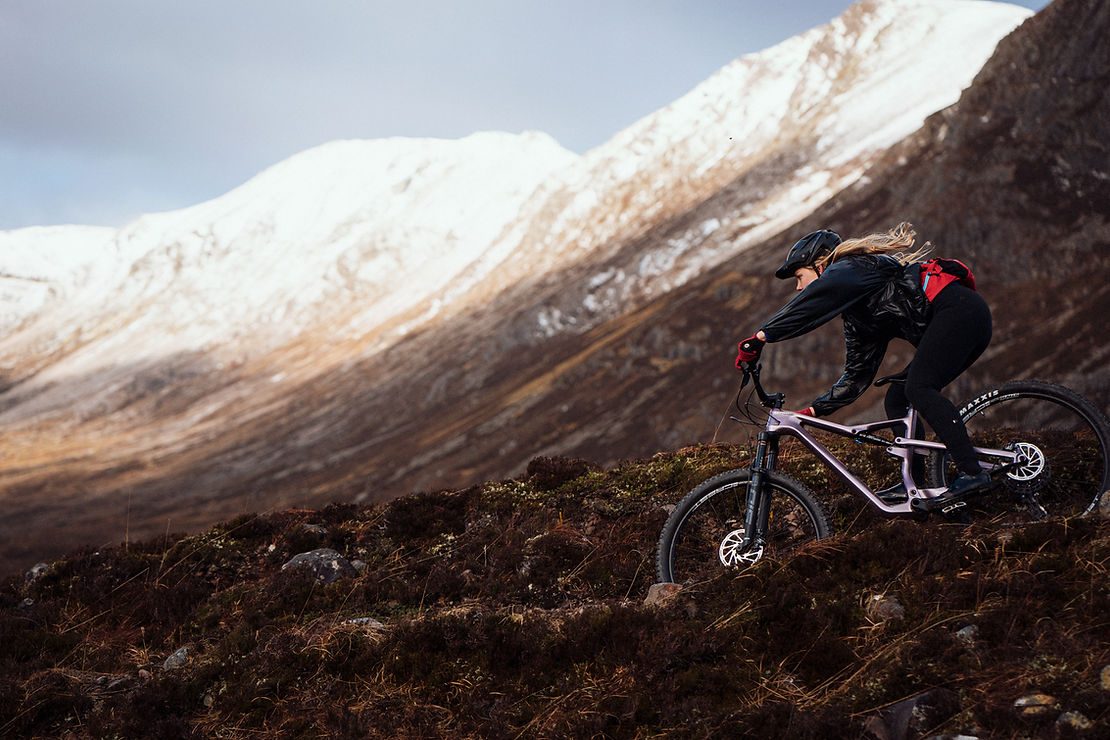
"The new Scalpel is one of the lightest full-suspension mountain bikes on the market, but that’s not even the best feature of the bike. The key to the Scalpel’s incredible performance is Cannondale’s new four-bar FlexPivot suspension. Patented durable carbon fiber flex zones act just like a Horst link pivot without the weight or flex of bolts and bearings. This also allows the bike’s suspension and overall frame-feel to be custom-tuned, by size, via Cannondale’s Proportional Response construction techniques. While others sacrifice performance to save weight, FlexPivot suspension delivers both – providing a ride that is ultra-light, with incredible grip, acceleration and control.
At just over 1900 grams complete with shock, the new Scalpel frame is one of the absolute lightest dual suspension MTB frames ever made. Cannondale’s Ai offset drivetrain delivers clearance for big 2.4” tires while keeping the chainstays short for traction and agility. Scalpel’s progressive geometry has evolved even further to a headtube angle that is a full degree and a half slacker and seat tube angle that is one-degree steeper compared to the outgoing bike. This, combined with Lefty’s extra-long fork offset, creates the latest version of Cannondale’s OutFront geometry giving riders more stability and confidence when things get rough, while keeping the steering responsive everywhere else.
For the ultimate marathon racer and high-speed trail slayer, there is the Scalpel SE version. It takes Scalpel’s trail capability and kicks it up a few notches bumping the travel from 100mm (front and rear) to a plush 120mm (front and rear) and slacking out the headtube angle even further. Larger volume 29” tires and a dropper post combine to deliver incredible speed and all-around capability. It’s the perfect machine for riders who prefer a superlight trail bike.
While suspension is the hero of the Scalpel story, the bikes also get Cannondale’s new STASH Kit. Built into the downtube under the water bottle mount, the STASH kit has everything needed for fast trailside repairs including a Fabric 8-in-1 mini tool in a quick-draw holster, a Dynaplug tubeless plug kit, and a place for a CO2 inflator or small mini pump."
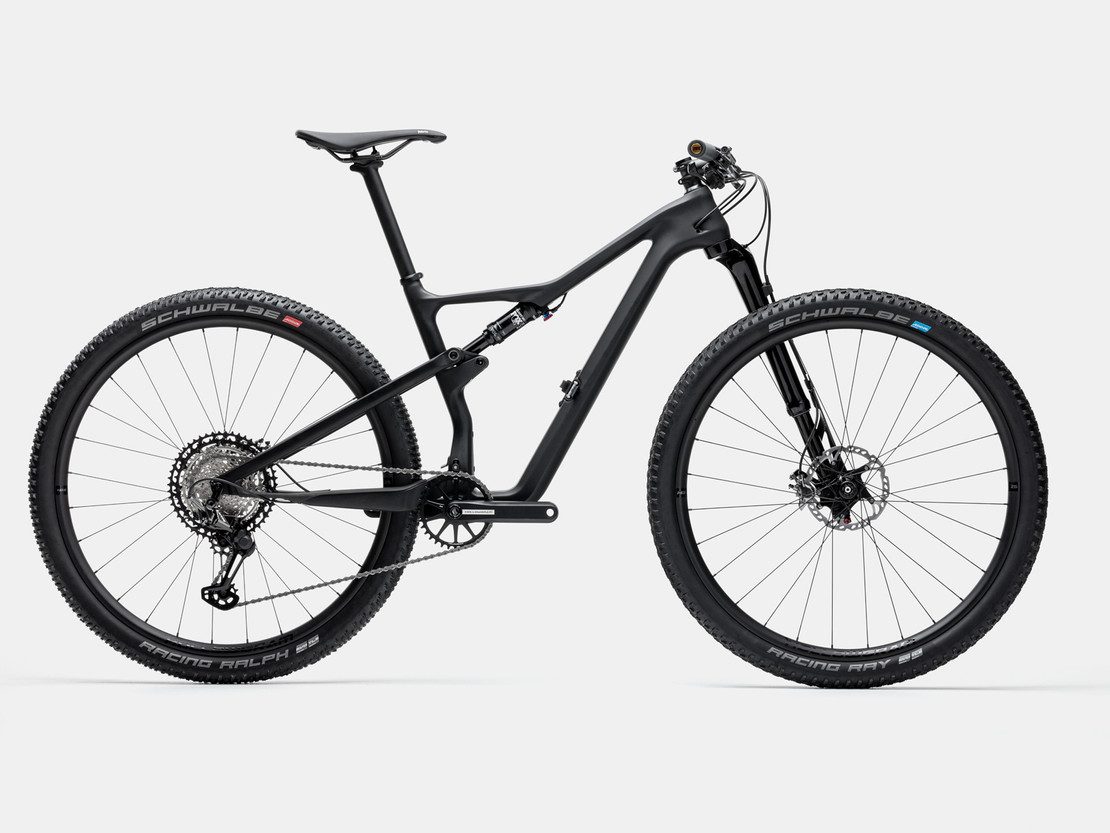
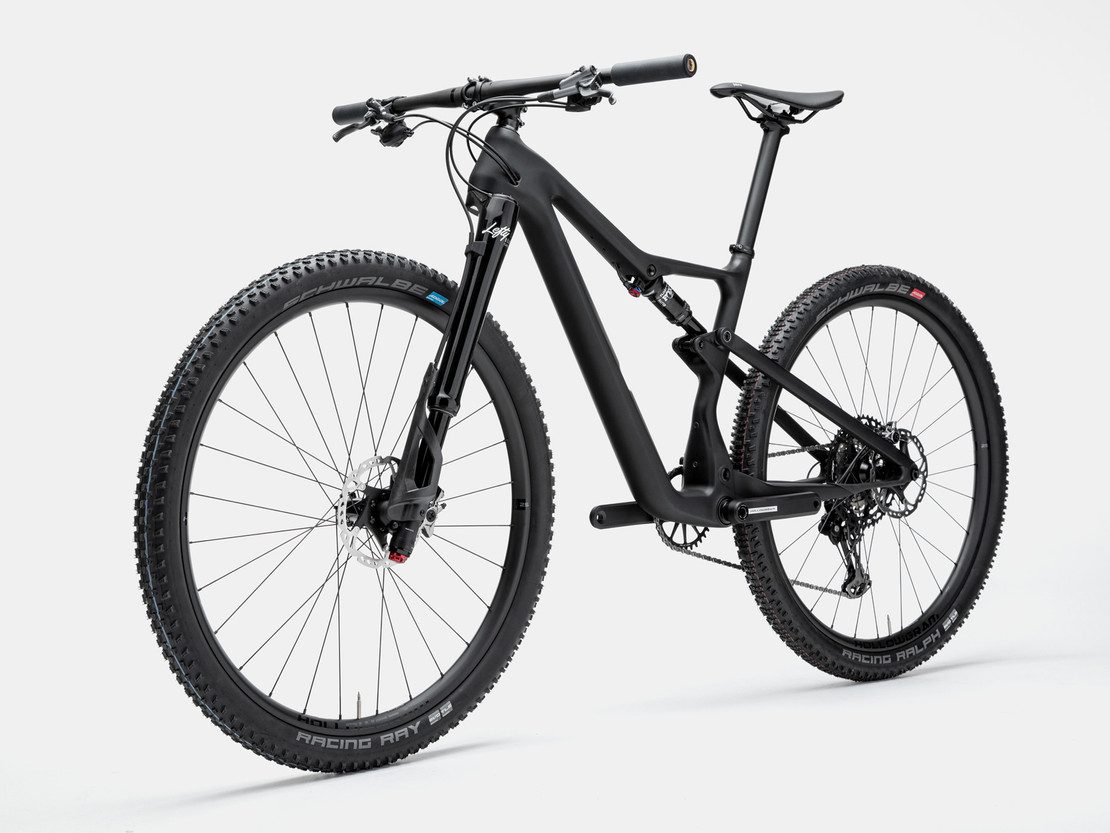




Story: Waitangi Mountain Bike Park
When we think of Waitangi, the birthplace of our nation, we tend to remember the TV broadcasts and headlines reporting the cultural politics that surrounds Waitangi Day each February. For those of us who have visited Waitangi, we also marvel at its stunning beaches and its never-ending farmland. Nowadays, the old lawlessness of the nearby early settler ports has been replaced by a thriving tourist industry. Yet few people know that Waitangi Mountain Bike Park is nestled beneath the tall pines of the Waitangi Endowment Forest, offering riders some 40kms of smooth, feature-filled flowy trails built by Southstar Trails and Ryan Lovett.
In early October I, along with a couple of mates, ventured up to the picturesque Bay of Islands to investigate what this new park has to offer. Although mother nature wasn’t on our side that weekend, the rain didn’t hinder our enthusiasm and eagerness to get out and try riding every trail in the park within the two days we had. Our overall assessment: the little-known Waitangi MTB Park deserves to be on every mountain-biker’s radar.
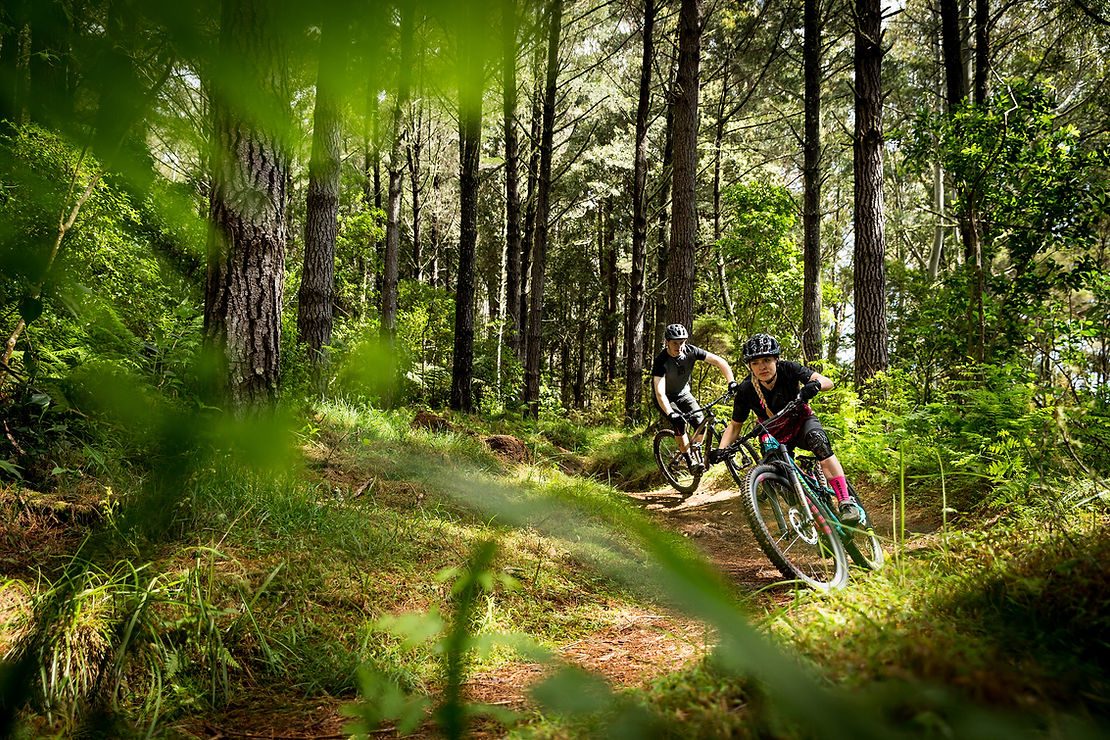
Location, Location, Location
Waitangi is only a brief three-hour drive north of Auckland. This is pretty much the same amount of time that it takes most Aucklanders to drive to Rotorua, which many mountain-bikers do weekend after weekend. For the same travel time, a trip up to the so-called winterless north is well worth it.
Once we arrived at Paihia we were instantly captured by the slow pace of the place and we quickly adapted to the beach lifestyle. It felt so much like we were on holiday that we almost forgot we had our bikes to ride. Almost.
Me and my mates — John and Amy — are no human compasses as we never have any idea which way is north. If it wasn’t for Johnny, the operator of Paihia Mountain Bike Rentals, we would’ve got completely lost. Johnny was quick to provide the key information we needed, including which were the ‘up’ trails and other important places within the park, as well as recommending which trails were worth riding first.
With Paihia township only ten minutes down the road, we had all the coffee, food and accommodation we needed to get and keep going. The park is well sign posted and easy to find. There is plenty of parking, which is all situated around a highly informative and striking hub / base map station.
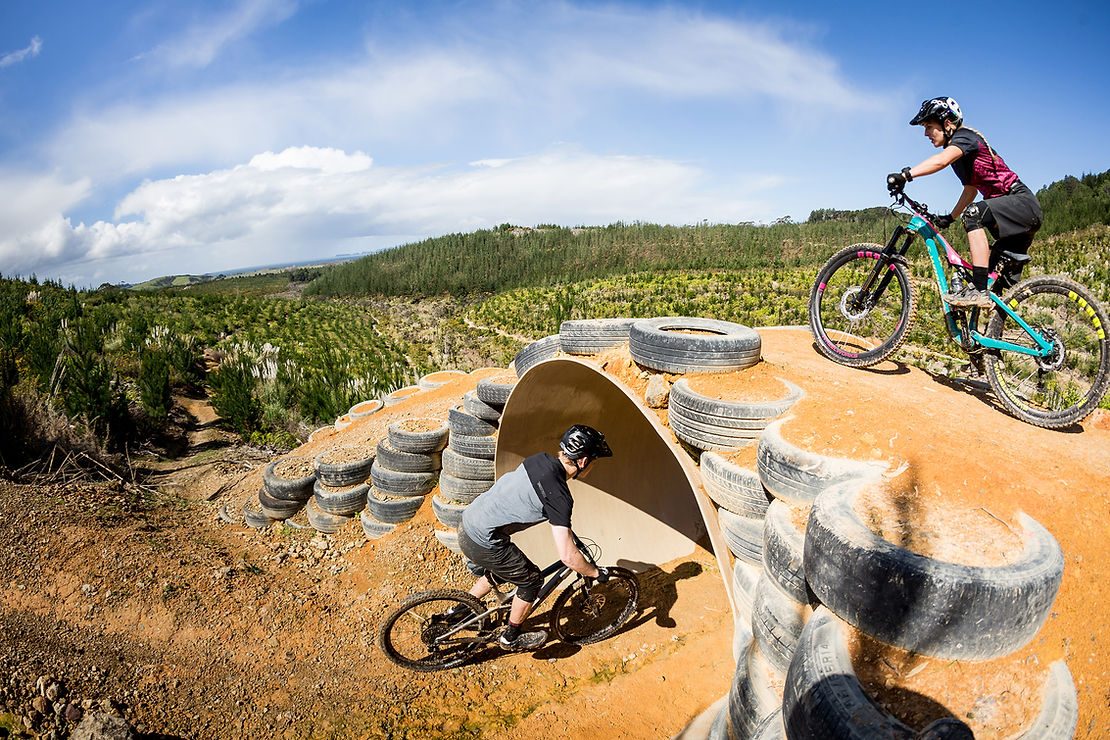
The Riding Experience
Although primarily clay-based, the lower parts of the trail network sit on a volcanic shelf, which makes for highly contrasting terrain as we climbed our way through the park. Starting off by meandering through gum trees and rolling over rocks, we then ventured up through young pine and into small pockets of native bush, erupting in bird song.
The park is divided into five zones, each with a different flavour and unique style of trail. Zones 1-3 were the first to be developed and feature 85% of the park’s trails. Luckily for us Zone 5 opened the day we got there: we had the honour of being the first riders to roll tyres over it. Situated at the very back of the park, and within the oldest pines on the property, these trails are built natural, rough and with minimal man-made features. While the trail surface was too soft and young for us to be able to really ride at pace, these mostly Grade 4 trails do have great potential for challenging riders on something other than a ‘bermed’ highway.
Zone 4 is yet to be developed, but is a primarily flat. Sitting on the same volcanic shelf as the lower trails of Zone 1, development will be slow and expensive, as trail building is incredibly laborious through all the rock. Their plans are to focus on building more grade 1-2 family loops and a skills park in due course.
Starting from the feet of the Pouwhenua, we rode through the gentle link trails of zone 1, up into the first trail forks of zone 2. Here, we began to wind our way up via a timid grade 2, 2km climb into the upper areas before dropping down into a section for grade 2 and 3 flow trails, or looping out and around Holland Days, a gentle XC loop than spans the lower, flatter areas of both zone 2 & 3.
Zone 3 is where the serious rider will spend most of their time. Littered with a myriad of fast, flow trails, with native sections and plenty of jumps, it is quite the playground. With all the trails in this zone linking back to the main climb, Te Rangi Hononga, it is easy to crank out laps without getting overly fatigued. Pakonga is the golden child within the park, a grade 4 jump trail that features large table tops and deep berms perched on the edge of a ridgeline. I also recommend riding Hookioi for the best mix of everything.
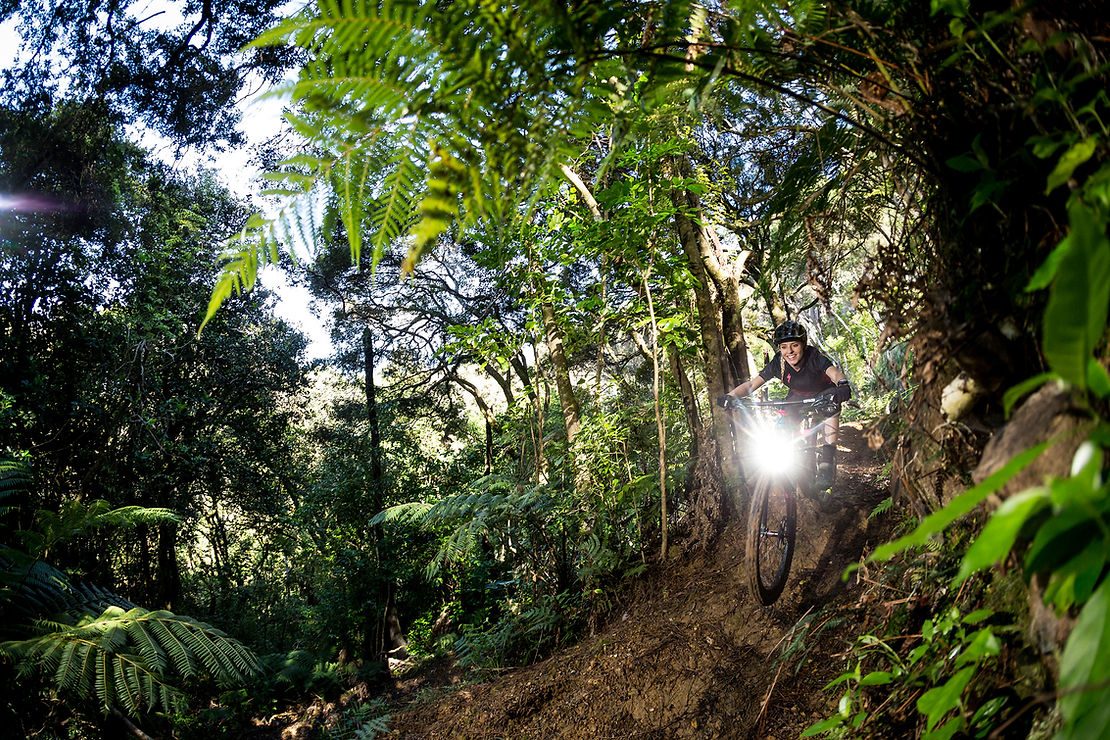
A Special Place
What really makes Waitangi Mountain Bike Park so special is the fact that it has been 100% community funded. Tiff Holland has really managed to rally the troops and unite the community to bring the park to life. The local ITM supplied all the timber for fencing and the hub area. The local jail provided prisoners to help clear trail, develop the grounds and do construction work. Tiff’s good friend provided a large amount of architecture and consulting free of charge. Everything for nothing — and all because they saw the same goal of creating something special for the local community.
It all started with a family trip to Rotorua some four years ago. The experience and epic trails captured Tiff so much (like it has for many of us), that her husband, Robin, exclaimed “How can we get one of these?” That quick remark set in motion the wheels on the Waitangi Mountain Bike Park project. Like anything in life, though, if it’s easy, then it probably isn’t worth the effort. Over the next few years, Tiff, who is the main driving force and front women for the project, set about scouting the perfect block of land, negotiating with several parties, including the land owners, local iwi, Department of Conservation, forestry management and Kiwi conservationists before starting the all-important fundraising efforts.
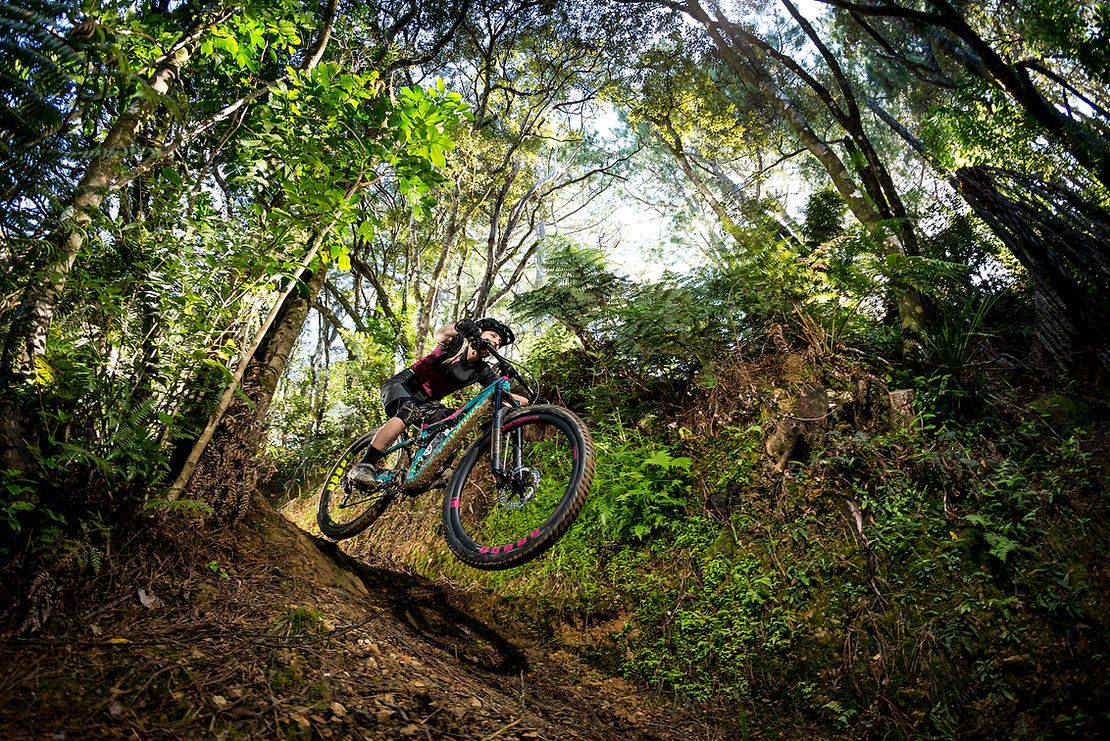
Final Reflections of a Happy Traveller
The quality of the park impressed me most. From trail design to signage, from drainage to dirt type, the park has been well thought out. We had to be strategic with our timing when venturing out from under tree cover due to the rain, but not once did we find the trails were drastically effected. Slippery in the odd spot, sure, but still plenty of fun with lots of grip and a big clean-up job after the ride - damn clay! The park does lack big elevation, though thanks to smart trail building, even the series rider will want to keep coming back. The trails are perfect for the family too, and even better for a brief holiday, giving yourself time for off the bike activities also.
Finally, I must say a big ‘thank you’ to Sauce Pizza Bar Paihia, The Scenic Hotels, Duke of Marlborough and Focus Paihia, as well as Tiff and Johnny for hosting us with a genuine friendliness which has always been a regional trait encountered by travellers heading North.
Words & Images: Cameron Mackenzie
Tech: Suspension 101
Ahh, suspension. It’s revolutionised our sport and taken us to new heights (literally). With a bit of tuning it can turn an ‘okay’ bike into a rocket-ship, assuming of course you’ve got the skills to keep up. In my eyes, your suspension system is probably the component group most worthy of your extra coin, but it’s probably also the most difficult thing on a mountain bike to wrap your head around and understand. Today I’ll give you a rundown on what does what so the next time you carry out a trail-side suspension tune-up you’re not aimlessly twisting the dials. Bear in mind, this is an introductory piece, so if you’re already a suspension guru you probably won’t take much away from this.
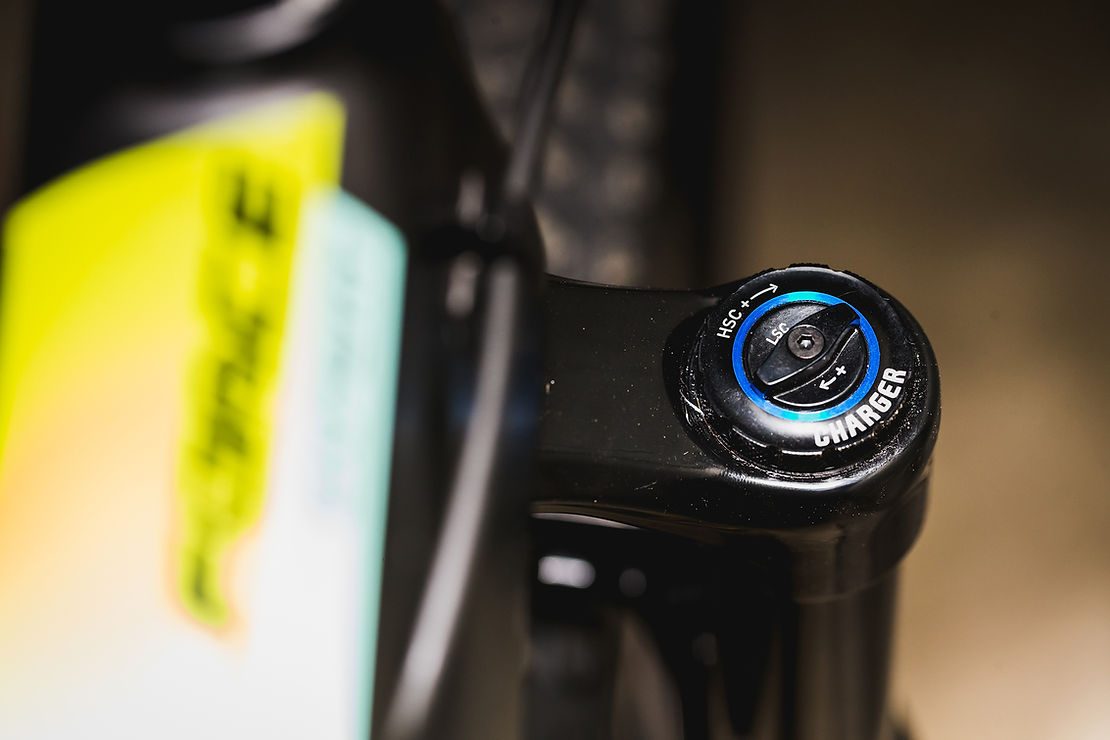
What is a damper and what is a spring?
To keep things simple, the spring is what offers resistance and supports your weight, while the damper controls how the spring acts. Essentially, the spring dictates how much force is required to compress your suspension, while the damper controls how quickly (or slowly) the suspension travels throughout its stroke, via compression and rebound adjustments.
Imagine a compressed spring. If you removed the force keeping it compressed, it would decompress and launch into the air uncontrollably. If that spring had a damper, it would dictate the speed at which the spring could decompress when you removed the compressing force. Finding the right suspension setup is a matter of balancing your spring rate and damper adjustments until everything acts in unison.
Air Springs vs Coil Springs
There are two main types of springs when it comes to mountain bike forks: air springs and coil springs. Air springs are a pressurized chamber within your fork or shock that can be pumped up via a shock pump. The biggest benefit to an air spring is tunability. With a shock pump you can add or remove air pressure in seconds to make the spring harder or softer and, with internal volume spacers, you can adjust your spring curve (we’ll touch on spring curves in a second). Air springs require more seals, and more seals mean more friction, affecting small bump sensitivity. More seals also mean more maintenance.
Coil springs are mechanical springs, the same as you’d expect to see on a car or most downhill bikes. They have a much more linear spring curve. Coil springs are heavier than air, but with less seals there’s less maintenance and they’re a lot more supple over small bumps. Coil springs are simpler to maintain and don’t have the overheating issues that can plague some air shocks on long descents. The biggest downside to coil springs, is that they don’t fit some frames and you’ll probably have to buy an extra spring suited to your weight, versus an air spring which can just be pumped up.
Put simply, spring curves are the relationship between the amount of force needed to compress your suspension versus the amount of travel used. A linear spring curve, for example, might take 40kg to compress it through half of its travel and 80kg to fully compress it, versus a progressive spring curve which might take 40kg to compress it halfway and 120kg to fully compress it. A linear spring will feel the same regardless of how much travel you’ve used, whereas a progressive spring will feel firmer the further through the travel you get.
The benefits to a linear spring curve are; plenty of traction at lower speeds and suspension that feels the same through the entire stroke, while sacrificing bottom-out resistance without upping spring rates. The benefits to a progressive spring rate are; a supply top stroke with plenty more bottom-out resistance, but too much progression can make it difficult to use all of your travel, particularly if you’re not an aggressive rider. The key thing to consider here, though, is that every full suspension bike’s linkage system will have its own characteristics that lean towards one of the two spring curves.
Rebound and Compression
Your damper controls two things: rebound and compression. Rebound controls how quickly your fork re-extends after being compressed, with compression controlling how quickly your fork compresses under load – go figure. Most forks and shocks feature a rebound adjustment dial and some sort of compression adjustment. Both adjustments have two options: high-speed and low-speed, however, it’s more common to see high-speed and low-speed compression adjustments than high and low speed rebound adjustments on suspension components. Speed is in reference to your shaft speed, as in how quickly your suspension is moving through its travel. A high-speed compression for example, would be when you hit a drop and the rear shock quickly has to absorb the impact. A low speed compression would be when you get on your front brakes and the fork compresses a little, in a relatively controlled manner before supporting your weight. Rebound is much the same, but most external rebound adjustments are for low-speed rebound, as this circuit is responsible for about two thirds of your travel, where your fork should spend most of its time working.
Wrap Up
I’ve just thrown a ton of information your way, so we’ll call it quits for this class. Next time round, we’ll look at how to set up your suspension and how to start diagnosing problems on the trail, to get you one step closer to a suspension system that floats over the rough and still gets your power down when you need.
Words: Cam Baker
Image: Cameron Mackenzie
Arrival: earSHOTS
I was pretty stoked when the postie arrived with these! earSHOTS are a Kiwi company making headphones for use in outdoor sports, specifically mountain biking. After five years of development, they're now available for purchase from their online store.
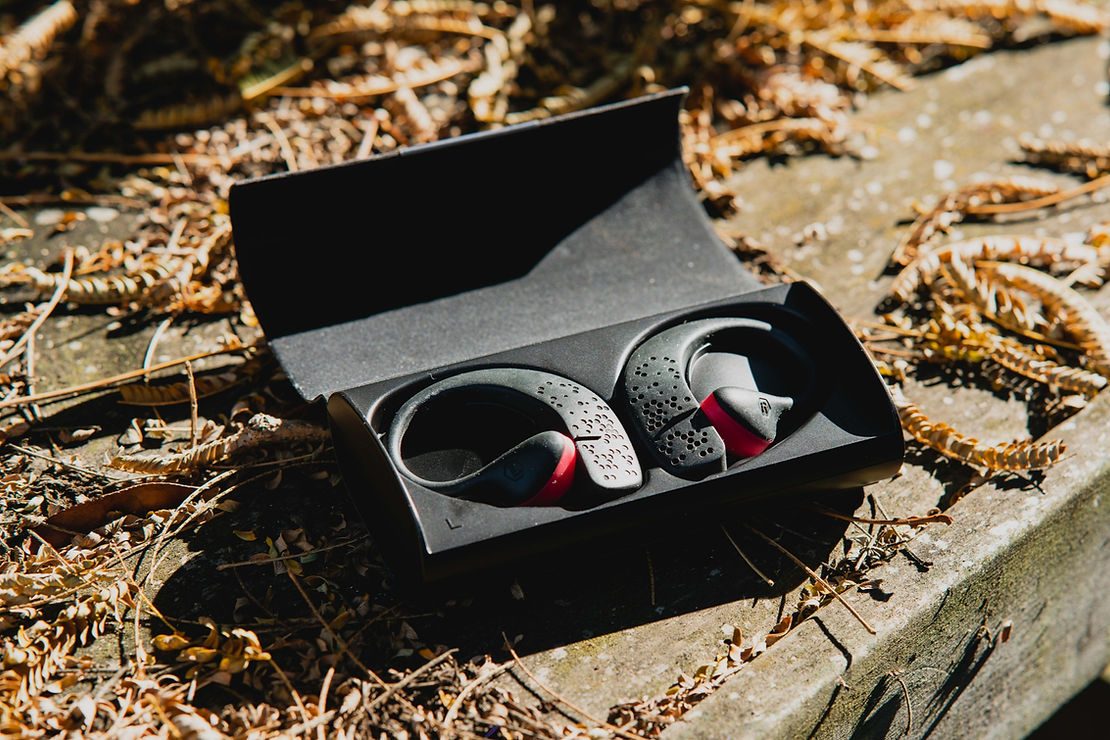
The earSHOTS are a wireless bluetooth headphone and come with an included charging case. As you'd expect, they're waterproof, and they also feature a magnetic clip that's designed to help them stay on your ears. I don't have a ton to say on them yet, other than the fact that they feel well built, are comfy and sound great, but you can be sure I'll put them through their paces and have a full review soon!
Words and Image: Cam Baker
Arrival: Neutron Components O.S.K
I think it's safe to say that carrying things on, or in your bike, is a way better option than loading up your pockets or a backpack (unless you want extra water or don't have a bottle cage - no judgement here). Neutron Components are a company based out of Taupo, and their Oh Shit Kit (O.S.K for short) aims to give you an easy way to carry all the tools you need.
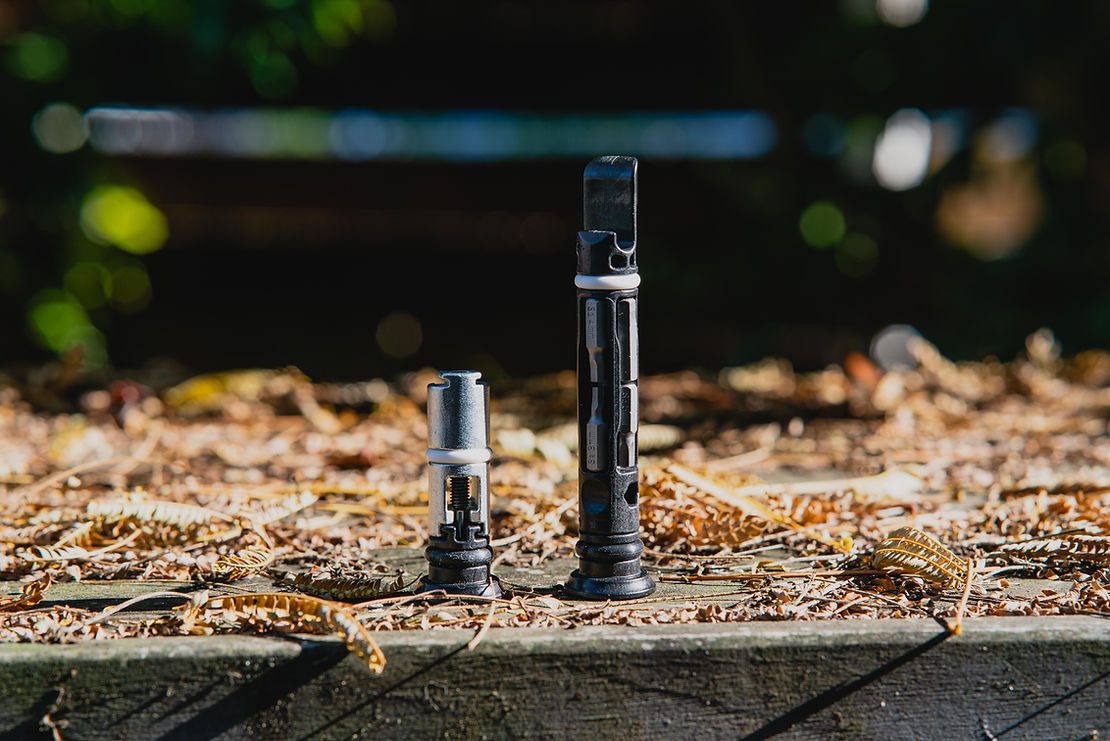
The O.S.K replaces your bar ends - one end housing your wrench (hex-keys, screwdriver, spoke wrench, tyre lever, valve core tool and bottle opener) and the other stores your chain breaker. The plastic base of the wrench feels durable, and the bits all feel like they'll survive any abuse you'd be able to throw at them when you have those oh-shit moments out in the woods.
Over the coming weeks I'll be putting the O.S.K through the ringer to make sure it stays where it should and does what it should but, as far as first impressions go, I'm impressed.
Words and Image: Cam Baker
Review: Unparallel Dust Up
Five Ten have owned the mountain bike shoe market for years, especially when it comes to flat pedal shoes. Unparallel is a new player to the market, with the aim to take a slice of the pie from Five Ten - and if anyone’s going to do it, they stand the best shot, with their founder being in charge of Five Ten’s production before Adidas took over the company.
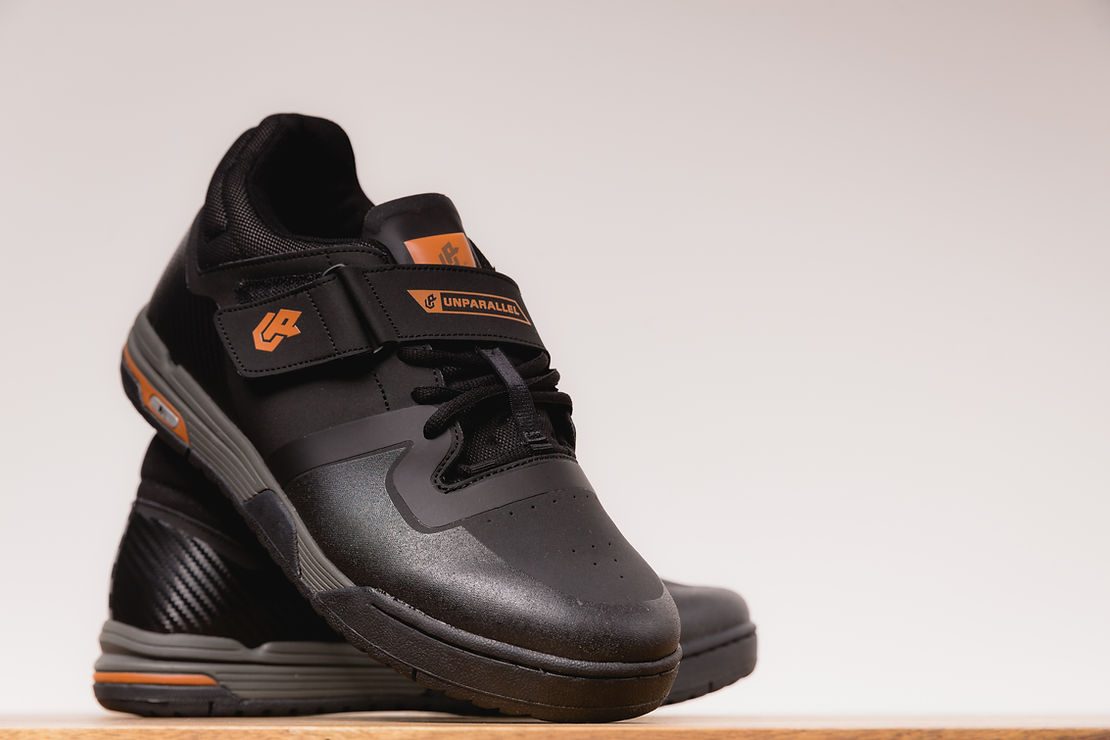
When Teva exited the mountain bike game, Unparallel bought the design and tooling for Teva’s sole, so if you feel like you’ve seen these shoes before, that’s probably why. The key difference here is the rubber. Unparallel have used their own rubber compounds. In the middle of the shoe, a 3.5mm 40-50 durometer rubber has been used, and is actually softer than Stealth rubber. The remainder of the sole is a 4mm 75-80 durometer rubber for more durability. The upper is synthetic, with laces and a Velcro pull-tab. Realistically, the Velcro just keeps the laces tidy, rather than helping cinch the shoe down.
We’ll start with what you care about most: grip. These shoes at least match Five Ten in terms of grip. Controversial statement, but it’s true. There’s not been a single time - wet or dry - that I’ve felt short-sold on grip. I say at least match because they grip differently, too. The UPs aren’t as stiff as Five Tens, but that’s not necessarily a bad thing. Some other shoes I’ve tried feel almost too stiff, in the sense it feels like you’re standing on a board on top of the pedals. With the UPs, you feel more ‘in the bike’ - but that’s not to say it’s for everyone. The sole of the UPs conform to the pedals and offers quite a bit more pedal feedback. The extra suppleness could be interpreted as ‘squirmy’ by some, but the reason I’m loving flats at the moment is for the pedal feedback, versus having the safety buffer of being able to drop a foot; and the UPs satisfy that.
The upper and overall fit, of the shoe is comfy, straight out of the box. I have freakishly high arches and semi-wide feet, so I typically run a size up for most of my riding shoes, however, in the case of the UPs I forgot to clarify whether the sizing was US or UK and ended up ordering a size up in US, which converts to being my true-shoe size in UK (i.e. a size smaller than what I’d usually get). I was pretty surprised at how well they fit and how comfy they were when I tried them on, and even more surprised when I didn’t get any new-shoe-pain on my first ride in them. What I will say, though, is that they’re roomy. Not in length, but in width and height. In my case they fit perfectly, but if you have narrow feet (which most Kiwis don’t - being Hobbits and that) you might find them a touch roomy. They do offer protection, but not quite as much as Five Tens, however, that’s not a bad thing, helping keep weight and overall bulk down.
The UPs have been incredibly impressive, and they’ve replaced my Five Tens as my go-to riding shoes. Their slightly smaller profile and pedal feel have won me over, as well as their straight-up comfort. However, I wouldn’t go as far as saying they’ve replaced them outright; if I was riding shuttles all day, or somewhere loose and rocky, I’d probably reach for the Five Tens simply for the little bit of added protection. What I will say though, is that these shoes are comparable with Five Tens and equally as grippy.
Words: Cam Baker
Image: Cameron Mackenzie

